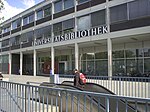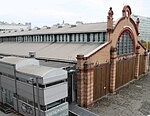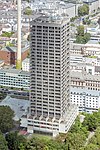Adorno-Ampel
1987 establishments in West GermanyBuildings and structures in FrankfurtTheodor W. AdornoTraffic signals

The Adorno traffic light is a traffic light artefact located in Frankfurt and named after Theodor W. Adorno. It has become one of Frankfurt's landmarks. The traffic light is on Senckenberganlage, a street which divides the Institute for Social Research from Goethe University Frankfurt. Adorno requested its construction after a pedestrian death in 1962, and it was finally installed 25 years later.
Excerpt from the Wikipedia article Adorno-Ampel (License: CC BY-SA 3.0, Authors, Images).Adorno-Ampel
Senckenberganlage, Frankfurt Westend Süd (Innenstadt 2)
Geographical coordinates (GPS) Address Nearby Places Show on map
Geographical coordinates (GPS)
| Latitude | Longitude |
|---|---|
| N 50.118316666667 ° | E 8.6529972222222 ° |
Address
Juridicum
Senckenberganlage 31
60325 Frankfurt, Westend Süd (Innenstadt 2)
Hesse, Germany
Open on Google Maps










